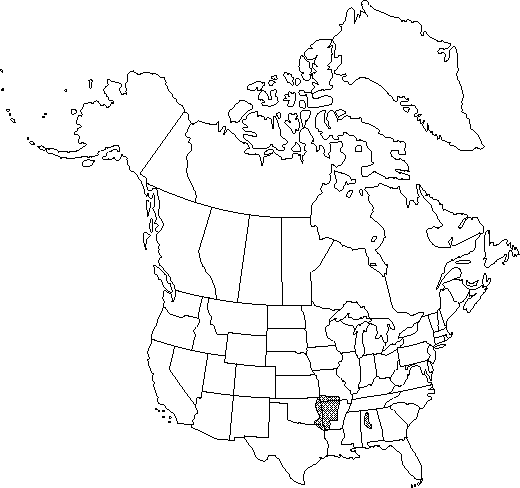Difference between revisions of "Castanea ozarkensis"
Bull. Torrey Bot. Club 50: 360. 1923.
FNA>Volume Importer |
FNA>Volume Importer |
||
| Line 27: | Line 27: | ||
}}<!-- | }}<!-- | ||
| − | --><span class="statement" id="st- | + | --><span class="statement" id="st-undefined" data-properties=""><b>Trees,</b> occasionally shrubs, previously often massive, to 20 m, now rarely more than 10 m, mostly resprouting following blight. <b>Bark</b> brownish, deeply or moderately fissured. <b>Twigs</b> glabrous when young. <b>Leaves</b>: petiole usually (8-)10-15 mm. <b>Leaf</b> blade narrowly obovate or oblanceolate, (40-)120-200(-260) × 30-100 mm, base rounded to slightly cordate or slightly cuneate, margins sharply serrate, each lateral vein terminating in cuneate, gradually acuminate tooth with awn usually more than 2 mm, apex acute or acuminate; surfaces abaxially densely to sparsely covered with appressed, whitish, minute, stellate trichomes, sometimes essentially glabrate, especially on shade leaves, veins glabrous or with a few simple trichomes. <b>Pistillate</b> flower 1 per cupule. <b>Fruits</b>: cupule 2-valved, enclosing 1 flower/fruit, valves irregularly dehiscing along 2 sutures, longest spines usually more than 10 mm; nut 1 per cupule, oval-conic, 9-19 × 8-14 mm, round in cross section, not flattened, beak less than 3mm excluding styles.</span><!-- |
-->{{Treatment/Body | -->{{Treatment/Body | ||
| Line 59: | Line 59: | ||
|publication year=1923 | |publication year=1923 | ||
|special status=Endemic | |special status=Endemic | ||
| − | |source xml=https://jpend@bitbucket.org/aafc-mbb/fna- | + | |source xml=https://jpend@bitbucket.org/aafc-mbb/fna-data-curation.git/src/9216fc802291cd3df363fd52122300479582ede7/coarse_grained_fna_xml/V3/V3_184.xml |
|genus=Castanea | |genus=Castanea | ||
|species=Castanea ozarkensis | |species=Castanea ozarkensis | ||
| − | |||
| − | |||
| − | |||
| − | |||
| − | |||
| − | |||
| − | |||
| − | |||
| − | |||
| − | |||
| − | |||
| − | |||
| − | |||
| − | |||
| − | |||
| − | |||
| − | |||
| − | |||
| − | |||
| − | |||
| − | |||
| − | |||
| − | |||
| − | |||
| − | |||
| − | |||
| − | |||
| − | |||
| − | |||
| − | |||
| − | |||
| − | |||
| − | |||
| − | |||
| − | |||
| − | |||
| − | |||
| − | |||
| − | |||
| − | |||
| − | |||
| − | |||
| − | |||
| − | |||
| − | |||
| − | |||
}}<!-- | }}<!-- | ||
-->[[Category:Treatment]][[Category:Castanea]] | -->[[Category:Treatment]][[Category:Castanea]] | ||
Revision as of 13:35, 27 July 2019
Trees, occasionally shrubs, previously often massive, to 20 m, now rarely more than 10 m, mostly resprouting following blight. Bark brownish, deeply or moderately fissured. Twigs glabrous when young. Leaves: petiole usually (8-)10-15 mm. Leaf blade narrowly obovate or oblanceolate, (40-)120-200(-260) × 30-100 mm, base rounded to slightly cordate or slightly cuneate, margins sharply serrate, each lateral vein terminating in cuneate, gradually acuminate tooth with awn usually more than 2 mm, apex acute or acuminate; surfaces abaxially densely to sparsely covered with appressed, whitish, minute, stellate trichomes, sometimes essentially glabrate, especially on shade leaves, veins glabrous or with a few simple trichomes. Pistillate flower 1 per cupule. Fruits: cupule 2-valved, enclosing 1 flower/fruit, valves irregularly dehiscing along 2 sutures, longest spines usually more than 10 mm; nut 1 per cupule, oval-conic, 9-19 × 8-14 mm, round in cross section, not flattened, beak less than 3mm excluding styles.
Phenology: Flowering June.
Habitat: Deciduous forest
Elevation: 150-600 m
Distribution

Ala., Ark., La., Mo., Okla., Tex.
Discussion
Castanea ozarkensis is concentrated in the Ozark Mountains, extending into the Ouachita Mountains (Arkansas) as well, where some intermediates with C.pumila may be found (G. E. Tucker 1975; G. P. Johnson 1988). Some authors have interpreted the putative hybrids as evidence to support inclusion of the Ozark chinkapin as a subspecies of C. pumila. Because virtually all chestnut species are interfertile, the occurrence of hybridization cannot be used as evidence of conspecificity, unless one is willing to accept a single chestnut species worldwide. The nature of the character differences between the Ozark populations and populations of C. pumila are substantial, and they are similar to differences seen between closely related species of Quercus, that nonetheless may hybridize locally. In many characteristics, C. ozarkensis differs from C. pumila in the direction of C. dentata (e.g., tree habit, glabrous twigs, leaf shape and size), including its resprouting pattern following chestnut blight (F. L. Paillet 1993). Given the ability of the chestnut to hybridize, and its intermediacy toward C.dentata, the origin of the Ozark chinquapin as a mere geographic race of C.pumila is questionable, and for the present, C. ozarkensis is best treated as a separate species.
Populations from northern Alabama are apparently no longer extant, probably eliminated by the chestnut blight (G. P. Johnson 1988).
Selected References
None.